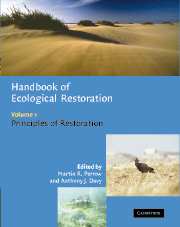Book contents
- Frontmatter
- Contents
- List of contributors
- Foreword
- Preface
- Part 1 The background
- Part 2 Manipulation of the physical environment
- Part 3 Manipulation of the chemical environment
- Part 4 Manipulation of the biota
- 12 Establishment and manipulation of plant populations and communities in terrestrial systems
- 13 Ecology and management of plants in aquatic ecosystems
- 14 Micro-organisms
- 15 Terrestrial invertebrates
- 16 Aquatic invertebrates
- 17 Fish
- 18 Reptiles and amphibians
- 19 Birds
- 20 Mammals
- Part 5 Monitoring and appraisal
- Index
- References
12 - Establishment and manipulation of plant populations and communities in terrestrial systems
Published online by Cambridge University Press: 29 December 2009
- Frontmatter
- Contents
- List of contributors
- Foreword
- Preface
- Part 1 The background
- Part 2 Manipulation of the physical environment
- Part 3 Manipulation of the chemical environment
- Part 4 Manipulation of the biota
- 12 Establishment and manipulation of plant populations and communities in terrestrial systems
- 13 Ecology and management of plants in aquatic ecosystems
- 14 Micro-organisms
- 15 Terrestrial invertebrates
- 16 Aquatic invertebrates
- 17 Fish
- 18 Reptiles and amphibians
- 19 Birds
- 20 Mammals
- Part 5 Monitoring and appraisal
- Index
- References
Summary
INTRODUCTION
The reconstruction of an appropriate plant community is a sine qua non for the restoration of any degraded ecosystem. Clearly, the plant communities of any ecosystem have an element of intrinsic distinctiveness that represents the biodiversity of the system. Furthermore, attempts to restore most other aspects of ecosystem structure and function cannot succeed, partially or wholly, without the authentic primary producers. The physical structure and chemical composition of the stands of plants that are established, combined with the specificity of many trophic relationships, strongly influence the potential for restoration of animal and microbial communities.
Plant communities are essentially dynamic, being the product of a combination of historical and current successional processes that involve interactions both between species and between the vegetation and the abiotic environment (Connell & Slatyer, 1977; Davy, 2000). Disturbance or damage to an ecosystem is likely to affect all aspects of its successional status, including soil development, accumulated nutrient and biomass capital, and nutrient cycling. Practical approaches to the establishment and manipulation of plant communities ignore this at their peril. For the purposes of restoration, landform and the properties of the soil environment are determinants of plant communities in two senses. Primarily, they are integrated attributes of successional status that are part of the functional specification of any ‘target’ ecosystem and hence the vegetation it can support.
- Type
- Chapter
- Information
- Handbook of Ecological Restoration , pp. 223 - 241Publisher: Cambridge University PressPrint publication year: 2002
References
- 24
- Cited by



